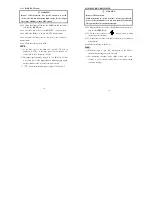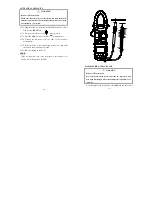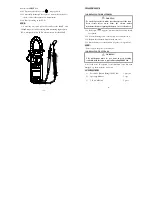
4.14.3
By HZ/DUTY range:
WARNING
Beware of Electrocution. Pay special attention to avoid
electric shock when measuring high voltage. Do not input
the voltage which more than 250V rms AC.
4.14.3.1 Plug the black test lead into the
COM
jack and the red test
lead into the
INPUT
jack.
4.14.2.2 Set the rotary selector to the HZ/DUTY range position.
4.14.2.3 Press the "
Hz/%
" to switch to DUTY measurement.
4.14.2.4 Connect test leads to the two end of the source or load for
measurement.
4.14.2.5 Take the reading on the LCD.
NOTE:
1) If the duty cycle is less than 10%, symbol ‘UL’ will be
displayed on LCD; if the duty cycle is more than 99.9%,
symbol ‘OL’ will be displayed on LCD.
3) The input signal frequency range is 10 – 10 kHz. It is possible
to test duty cycle of the higher than 10 kHz frequency signal,
but the tolerance of the test result can not be ensure.
3) “
” means the maximum input voltage is 750V rms AC.
- 32 -
4.15 MEASURING RESISTANCE
WARNING
Beware of Electrocution.
When measuring in-circuit resistance, make sure that the
power of the circuit under test has been turned off and that
all capacitors have been fully discharged.
4.15.1 Plug the black test lead into the
COM
jack and the red test
lead into the
INPUT
jack.
4.15.2 Set the rotary selector to the range position to make
the meter get into
Ω
range.
4.15.3 Connect the test leads to the ends of the resistor or circuit for
measurement.
4.15.4 Take the reading on the LCD.
NOTE:
1) When the input is open, ‘OL’ will appear on the LCD to
indicate that the range has been exceeded.
2) For measuring resistance above 1M
Ω
, it may take a few
seconds to get a steady reading. This is normal for high
resistance reading.
- 33 -
Summary of Contents for MS2108A
Page 5: ... 6 7 ...
Page 22: ...HYS006169 ...





































